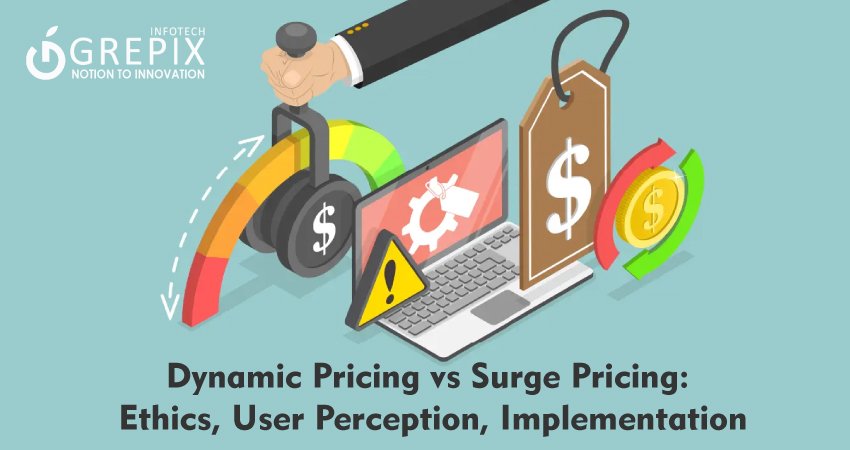Dynamic Pricing vs Surge Pricing: Ethics, User Perception, Implementation
The taxi app industry has reshaped how people commute, offering affordability, convenience, and quick access to rides. However, the most debated aspect of these services lies in their pricing models. Terms like dynamic pricing taxi app and surge pricing Uber often confuse riders and regulators alike. Both fall under demand-supply-based ride-hailing price strategies, yet they impact user perception differently.
The ride-hailing industry has transformed global urban mobility, thanks to innovative pricing models like dynamic pricing taxi apps and surge pricing Uber. These strategies adjust fares in real-time based on demand, supply, and external conditions, optimizing driver incentives and app revenues. However, while effective, they spark debates around fairness, ethics, and user trust. This article explores the differences between dynamic pricing and surge pricing, their implementation in taxi app pricing models, and the best practices that leading companies follow to balance profitability and customer satisfaction. With real-world examples and insights into the ethics of ride-hailing price strategies, we highlight how transparent communication and AI-driven models can improve user trust while maintaining revenue growth. Whether you’re an entrepreneur launching a taxi app or a curious user experiencing fare hikes, this guide gives you a complete understanding of ride-hailing price strategies and how they shape the future of mobility.
Surge Pricing in Ride-Hailing
This in-depth guide compares dynamic pricing vs surge pricing, explores their ethical implications, and discusses best practices for a transparent, user-friendly taxi app pricing model.
What is Surge Pricing?
Surge pricing is a strategy where fares increase when ride demand outpaces driver availability. In Uber’s case, this often occurs during peak hours, severe weather, concerts, or emergencies. A multiplier (e.g., 1.5x, 2x, or higher) is applied to the base fare.
Real-World Uber Example
- During New Year’s Eve in 2015, Uber faced backlash when customers reported extremely high fares, with some trips costing over $300.
- In Chicago, studies revealed surge pricing led to 121% higher fares during rainstorms compared to baseline pricing.
User Perception
- Positive: Fast driver availability as higher fares incentivize drivers.
- Negative: Perceived as price gouging, especially during emergencies or crises, leading to negative press.
Dynamic Pricing in Taxi Apps
What is Dynamic Pricing?
Dynamic pricing taxi app models use algorithms that constantly adjust fares based on multiple factors:
- Supply-demand balance
- Traffic congestion
- Fuel costs
- Distance and route variations
- Seasonal patterns
Unlike surge pricing, which applies sudden fare multipliers, dynamic pricing evolves smoothly over time.
Case Study: Ola Cabs (India)
Ola adopts dynamic pricing with limits. For example, fare hikes during peak hours are capped by regulations in certain states, preventing exponential price surges.
User Perception
- Positive: Considered more predictable and less exploitative.
- Negative: Riders may still feel fares fluctuate too often, but transparency helps build trust.
Dynamic Pricing Taxi App vs Surge Pricing Uber
| Feature | Dynamic Pricing Taxi App | Surge Pricing Uber |
|---|---|---|
| Pricing Basis | Gradual, algorithm-based real-time adjustments | Sudden multiplier applied during high demand |
| Customer Trust | Higher (due to predictability and caps) | Lower (perception of exploitation) |
| Driver Incentive | Moderate, consistent earnings boost | High during peak surges |
| Ethical Perception | Fairer, as changes are gradual | Often seen as price gouging |
| Best Use Case | Long-term, sustainable taxi app pricing models | Short-term, emergency driver availability |
Ethical Concerns Surrounding Ride-Hailing Price Strategy
Fairness to Riders
- Sudden fare spikes during natural disasters or emergencies create ethical dilemmas. Riders may pay exorbitant amounts when they have no other options.
Regulatory Restrictions
- In New Delhi, India, regulators capped fare surges at 3x base fare to protect users.
User Trust
- Transparency matters. According to a survey, 74% of riders feel exploited if fare hikes are not clearly communicated.
AI Algorithm Bias
- Algorithms may prioritize profit over fairness, inadvertently leading to social inequities in pricing.
Best Practices for Taxi App Pricing Models
Transparency in Pricing
Show real-time fare breakdowns before booking, explaining why the fare is higher or lower.
Caps on Surge Multipliers
Avoid unrestricted surges. For example, limiting surge fare to 2x–3x reduces ethical concerns.
Predictive Notifications
Inform users in advance using push notifications about upcoming peak periods.
Driver Incentives
Offer bonuses rather than solely relying on surge pricing, balancing earnings with rider satisfaction.
AI-Powered Fair Algorithms
Implement balanced ride-hailing price strategy models that optimize both driver availability and customer affordability.
Conclusion
Dynamic pricing and surge pricing both play a crucial role in shaping the taxi app pricing model, but their ethical and experiential impact differs significantly. While surge pricing Uber ensures rapid driver response during peak demand, it risks alienating users who perceive fare hikes as unfair. On the other hand, a well-designed dynamic pricing taxi app model ensures smoother adjustments, building long-term trust while maintaining profitability.
For taxi app entrepreneurs, adopting transparent communication, capped surges, and AI-driven predictive models can create a fairer ride-hailing ecosystem. Riders appreciate clarity. A report by Deloitte found that 84% of customers are willing to pay slightly higher fares if they understand the rationale behind pricing.
The future of ride-hailing price strategy lies in finding the right balance between ethical fairness and business sustainability. Companies that put user trust at the core of their taxi app pricing model will build stronger loyalty and long-term brand equity.
If you’re building a taxi app or analyzing Uber’s pricing model, remember: pricing isn’t just about numbers it’s about trust. Share this article with entrepreneurs and riders alike to spread clarity on how pricing strategies shape the future of mobility.
FAQs
1. What is the difference between surge pricing and dynamic pricing?
Surge pricing applies sudden multipliers during peak demand, while dynamic pricing adjusts fares gradually using multiple variables.
2. Why does Uber use surge pricing?
Uber uses surge pricing to encourage more drivers to get on the road during high demand, ensuring faster ride availability.
3. Are dynamic pricing taxi apps more ethical?
Yes, because they implement gradual changes with caps to avoid sudden unfair hikes, making them more transparent and predictable.
4. How do regulators control taxi app pricing models?
Regulators often set surge limits and require apps to display transparent pricing details before booking a ride.
5. What is the best ride-hailing price strategy?
A hybrid model, combining capped surge pricing with AI-driven dynamic pricing, offers fairness while maintaining driver incentives.







